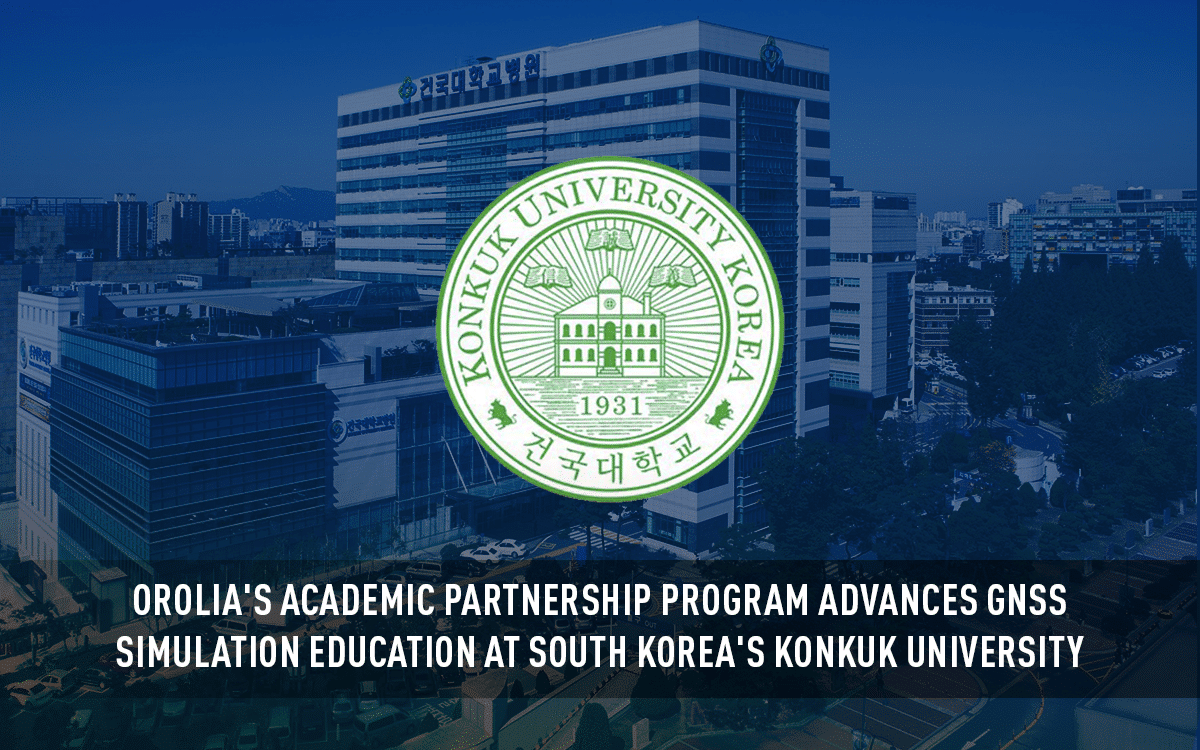
Orolia's Academic Partnership Program Advances GNSS Simulation Education at South Korea's Konkuk University
Educators Introduce Students to Skydel GNSS Simulation Engine As South Korean Government Prepares to Launch New Global Satellite Navigation System
Konkuk University is the first school in South Korea to join the Orolia Academic Partnership Program. Dr. Hans Kim with the Graduate School of Information and Telecommunications describes how access to the Skydel GNSS simulation engine has fueled engineering education and student research.
Orolia: Why is GNSS simulation education important in today’s engineering studies?
Dr. Kim: “So far, satellite navigation education has been studied only through textbooks or MatLab-based coding. However, it has not been possible to teach practical implementation skills. GNSS simulation education fills this gap and allows students to immediately test the results implemented in practice so that they can develop skills that will be highly valuable in practice when they find a job at a company or research institute after completing their studies.”
Orolia: Can you describe how Skydel has played a role in student learning and research projects?
Dr. Kim: “I believe that university research projects should use tools that have no limitations or restrictions on an idea and its implementation. This is because creativity can be included in the research. In this respect, I think SDR-based skydel is valuable as a very useful and limitless tool for satellite navigation system research and development.”
Orolia: Could you please share more information about specific research projects?
Multi-GNSS & PP: We are receiving signals from many navigation satellites right now. It’s a very different environment from the early GPS-only days. This research topic is a study on the technology of combining other navigation system satellites and improving correction and accuracy through it.
Integrated Navigation: The integrated navigation topic is to study and simulate the combined technology required to integrate the satellite navigation system and the inertial navigation system. And it is to develop a technology to develop and apply simulation tools to obtain test results similar to the actual field environment in the laboratory for this convergence navigation.
Realtime Simulation: As research to develop simulation technology as a tool for real-time testing, we study technology that minimizes navigation signal generation time and methods and conditions for inputting positional coordinates necessary for navigation signal generation in real-time. I think this technology will be essential for implementing a satellite navigation system indoors in the future.
Realtime Test (HIL): No one can evaluate the quality of the current navigation system, nor can it be certified. This research topic aims to develop verification and certification technologies that are essential for realizing a Korean satellite navigation system in the future.
KASS & KPS: KASS is a Korean SBAS, and KPS is a Korean satellite navigation system. These two systems are scheduled to be realized in Korea, and it is expected that a lot of research and development will be conducted on the utilization and application of these two systems in the future. This research topic plans to realize the basic research for this using Skydel. Although Skydel does not yet have the ability to simulate KASS and KPS, we plan to conduct research and development using the CUSTOM SIGNAL generation function.
Orolia: Was Skydel difficult to learn?
Dr. Kim: “When I first introduced Skydel as an educational tool, I think students thought it was difficult to access. However, after getting used to the eyes and understanding the structure, they realized that they could experience both the beginning and the end of the satellite navigation system, which they had only studied theoretically, and responded that they were very interested. And their response is that they desire to use this tool very well.”
Orolia: What advice do you have for educators who want to incorporate Skydel into their curriculum?
Dr. Kim: “I think that in order to teach the satellite navigation system to students using Skydel, it is necessary to understand the structure and configuration of the satellite navigation system in advance. Students who encounter skydel for the first time have a common feeling that they are studying how to use one of the simulation equipment. In order to understand this tool as a tool that simulates the reception of signals generated by navigation satellites on the ground, it is easy to approach skydel only if they understand the structure of the satellite navigation system at least.”
Orolia: How will the university use Skydel in the future?
Dr. Kim: “To implement various simulations that we are aiming for using Skydel, we need to use tools such as N310 or DEKTEC, which are general-purpose equipment, so they are expensive and have many unnecessary functions. I really want to develop a dedicated RF device for Skydel simulation.


